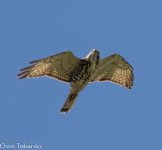-
Welcome to BirdForum, the internet's largest birding community with thousands of members from all over the world. The forums are dedicated to wild birds, birding, binoculars and equipment and all that goes with it.
Please register for an account to take part in the discussions in the forum, post your pictures in the gallery and more.
You are using an out of date browser. It may not display this or other websites correctly.
You should upgrade or use an alternative browser.
You should upgrade or use an alternative browser.
American Kestrel (1 Viewer)
- Thread starter 49bentley
- Start date
More options
Who Replied?dwatsonbirder
Well-known member
Looks like an immature Double toothed kite, but only saw a handful way back in 2013: https://www.hbw.com/ibc/photo/double-toothed-kite-harpagus-bidentatus/juvenile-flight

Looks like an immature Double toothed kite, but only saw a handful way back in 2013: https://www.hbw.com/ibc/photo/double-toothed-kite-harpagus-bidentatus/juvenile-flight
I think this might be a better shout
Niels
The Bird Nuts
Birding Duo
Tail pattern fits young Gray Hawk better.
Tail pattern fits young Gray Hawk better.
Agree. Neither broad-winged kite nor double-toothed kite for me
Jeff Hopkins
Just another...observer

I'm with The Bird Nuts. Immature Grey Hawk.
pbjosh
missing the neotropics

I'm not certain I'm 100% confident on Gray Hawk. The tail banding (fewer bars, terminal bar much stronger than other bars) and dark fringe to the flight feathers look better for immature Broad-winged Hawk. The really contrasting chest markings look better for Gray Hawk. Spacing of the barring in the remiges also favors Broad-winged Hawk. It's hard to tell just how pale the cheek is - while it appears pale-ish it is hard to interpret how much is photo artifact, and of course juvenile Broad-winged Hawks can have pale-ish cheeks even if, on average, they are darker headed/cheeked than juevenile Gray Hawks. Both appear to be about equally likely for your location.
I don't pretend to be an expert but the spacing of the barring on the tail and flight feathers and the pale subterminal bars on the tail make me lean towards Broad-winged Hawk.
A good comparison here, if you scroll the two photos to juveniles of the respective species:
https://www.allaboutbirds.org/guide/Gray_Hawk/species-compare/
Scroll two to the left for "Main Species" to get a juvenile Gray Hawk, and one to the left for "Similar Species" to get a juvenile Broad-winged.
If others feel strongly it's a Gray Hawk I'd love to learn from the discussion.
Cheers all,
Josh
I don't pretend to be an expert but the spacing of the barring on the tail and flight feathers and the pale subterminal bars on the tail make me lean towards Broad-winged Hawk.
A good comparison here, if you scroll the two photos to juveniles of the respective species:
https://www.allaboutbirds.org/guide/Gray_Hawk/species-compare/
Scroll two to the left for "Main Species" to get a juvenile Gray Hawk, and one to the left for "Similar Species" to get a juvenile Broad-winged.
If others feel strongly it's a Gray Hawk I'd love to learn from the discussion.
Cheers all,
Josh
dwatsonbirder
Well-known member
I'm with Josh, I think the that pattern on the tail (darker terminal band than sub-terminal bands) and tertials doesn't look right for Gray hawk, also the markings appear larger and more extensive on the auxiliaries (better fit for Broad winged than double toothed kite). I'm not sure if this is an ID feature, but all the images I can find of Gray hawk show five obvious primaries, whereas this bird (and BwH and DtK) show four.
I'm in a similar position in that I don't have a huge amount of field experience with these species, but I'd be interested to hear opinions from those who have!
I'm in a similar position in that I don't have a huge amount of field experience with these species, but I'd be interested to hear opinions from those who have!
Last edited:
pbjosh
missing the neotropics

I also looked at the 4 vs 5 primary "fingers" bit Daniel, though didn't feel I was as certain I was interpreting it correctly. I do think I see 4 vs 5, which again points at BwH.
I would say that the wing structure of DT Kite is really different with shorter outer primaries and a secondary bulge that gives a classic "paddle" shape to the wings. Many other neotropical raptors that are more forest based such as Hook-billed Kite, Gray-headed Kite, the Hawk-Eagles, Black-and-Chestnut Eagle have similar paddle shaped wings that really look quite different, in my opinion. As well, DT Kite has a really small head that, to me, always looks cylindrical and kind of neckless.
I would say that the wing structure of DT Kite is really different with shorter outer primaries and a secondary bulge that gives a classic "paddle" shape to the wings. Many other neotropical raptors that are more forest based such as Hook-billed Kite, Gray-headed Kite, the Hawk-Eagles, Black-and-Chestnut Eagle have similar paddle shaped wings that really look quite different, in my opinion. As well, DT Kite has a really small head that, to me, always looks cylindrical and kind of neckless.
Birdingcraft
Well-known member
My immediate impression was Gray Hawk but yeah, could be a Broad-winged. One of those situations that could use another photo or two.
Users who are viewing this thread
Total: 2 (members: 0, guests: 2)





